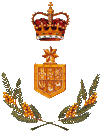Australian Gallantry and Distinguished Service Awards
A range of awards to recognise gallantry and distinguished service was introduced to the Australian system to replace Imperial awards in 1991. The only award retained from the Imperial system is the Victoria Cross, which was renamed Victoria Cross for Australia. (Gallantry Award recipients are eligible to join the Australian Bravery Association.)
The key differences between the Australian awards and those of the Imperial system are that the awards are applied to all the Services, and that the level of the award is not restricted by rank but is determined by the quality of the action or service. To download the current Imperial Medals Booklet produced by the UK Ministry of Defence Click Here.
A further difference is the establishment of unit awards for gallantry and distinguished service, which were not previously available under the Imperial system.
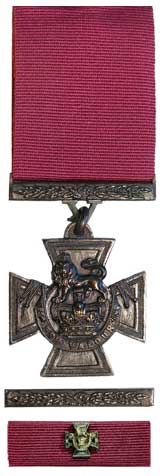 |
Victoria Cross for Australia All ranks of the Services may be nominated for this award. The VC was awarded to Australians under the Imperial system of awards, with 96 Australians receiving the award. It was decided to retain the VC as the pre-eminent gallantry award in the Australian system. The VC is awarded for the most conspicuous gallantry, or a daring or pre-eminent act of valour or self-sacrifice, or extreme devotion to duty in the face of the enemy. The Victoria Cross for Australia was approved on 15 January 1991. The first Victoria Cross for Australia was awarded to Trooper Mark Gregor Donaldson VC for his most conspicuous acts of gallantary in circumstances of great peril in Afghanistan. Insignia The Victoria Cross for Australia is identical to the original VC. It is a bronze cross with the obverse having a Crowned Lion standing on the Royal Crown with the words “FOR VALOUR” inscribed on a semicircular scroll below the Crown. The reverse has the date of the act for which the Cross is awarded engraved within a circle in the centre. The Cross is suspended by a ring from a seriffed “V” attached to a suspension bar decorated with laurel leaves. Ribbon The VC ribbon is crimson and 38 mm wide. When the ribbon is worn alone a ribbon bar emblem in the form of a replica of the Cross is worn on the ribbon. Further Awards A further award of the VC is denoted by a bronze bar. When the ribbon is worn alone, the award of a bar is indicated by the addition of a further ribbon bar emblem. Postnominal Recipients of the Victoria Cross are entitled to the postnominal letters ‘VC’. Recipients of a bar to the VC add ‘and Bar’ to the postnominal. The VC is worn ahead of all other awards. |
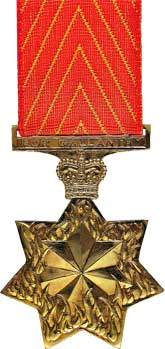 |
The Star of Gallantry (SG) was introduced in 1991 and is awarded for acts of great heroism or conspicuous gallantry in action in circumstances of great peril. Insignia The SG is a gold-plated Federation Star, with the obverse having a central device of a smaller Federation Star in a field of flames. The reverse has a central panel for recipient details on a stepped background. The suspension bar is inscribed on both obverse and reverse with “FOR GALLANTRY”. Ribbon The SG ribbon has a design of chevrons of deep orange alternating with chevrons of light orange. The ribbon is worn with the points facing upwards. Further Awards A further award of the SG is denoted by a gold-plated bar with the Federation Star on a horizontal row of flames. When the ribbon is worn alone, the award of a bar is indicated by a ribbon bar emblem in the form of a gold-plated Federation Star. Postnominal Recipients of the Star of Gallantry are entitled to the postnominal letters ‘SG’. Recipients of a bar to the SG add ‘and Bar’ to the post-nominal. |
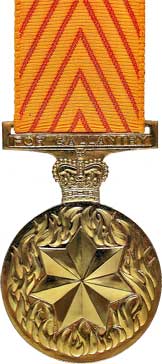 |
The Medal for Gallantry (MG) was introduced in 1991 and is awarded for acts of gallantry in action in hazardous circumstances. Medal The MG is a gold-plated medal with the obverse having a central device of a Federation Star on a circle of flames representing action under fire. The reverse has a panel for recipient detail over a design of fluted rays of varying lengths. The suspension bar is inscribed on both obverse and reverse with “FOR GALLANTRY”. Ribbon The MG ribbon has a design of chevrons of light orange alternating with chevrons of deep orange. The ribbon is worn with the points facing upwards. Further Awards A further award of the MG is denoted by a gold-plated bar having the Federation Star on a horizontal row of flames. When the ribbon is worn alone, the award of a bar is indicated by a ribbon bar emblem in the form of a Federation Star on a gold-plated disc. Postnominal Recipients of the Medal for Gallantry are entitled to the postnominal letters ‘MG’. Recipients of a bar to the MG add ‘and Bar’ to the postnominal. |
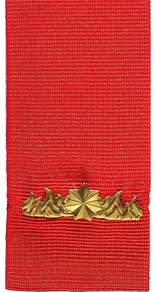 |
The Commendation for Gallantry was introduced in 1991 and awarded for acts of gallantry in action which are considered worthy of recognition. Insignia The insignia of the Commendation for Gallantry is gold-plated with a Federation Star superimposed centrally on a row of flames. Ribbon The Commendation for Gallantry insignia is mounted on a plain orange ribbon. A miniature insignia is worn on the ribbon bar. Further Awards Further awards of the Commendation for Gallantry are made by Warrant describing the separate action being recognise. No additional insignia is received or worn. Postnominal There is no entitlement to postnominal letters for recipients of the Commendation for Gallantry. |
